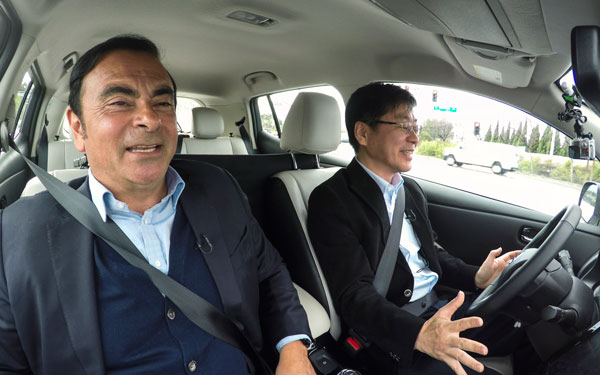
Chairman and CEO of Renault-Nissan Alliance Carlos Ghosn (left) takes the passenger seat in an autonomous car while Tetsuya Ijima, in charge of developing advanced driver assistance systems for Nissan Motor, relinquishes control of the vehicle. (Photo/China Daily)
Renault Nissan executives are eager to bring the company's autonomous driving technologies to China soon, to join those already being used as safety features by Dongfeng Nissan, Nissan Motor's joint venture in the country with Dongfeng Motor.
Renault Nissan, the world's fourth-largest car manufacturer by sales volume, announced on Wednesday it plans to launch more than 10 models with autonomous driving technologies in the United States, Europe, Japan and China through 2020. It promised that cars capable of autonomous functions would be mainstream and mass-produced, at affordable prices.
Renault-Nissan Alliance Chairman and CEO Carlos Ghosn, speaking at the Renault-Nissan Silicon Valley Research Center, said: "Renault-Nissan is deeply committed to the goals of zero emissions and zero fatalities. That's why we are developing autonomous driving and connectivity for mass-market, mainstream vehicles on three continents."
This year marked Renault-Nissan's debut of vehicles with "single-lane control," a feature that allows them to drive autonomously on highways, including in heavy, stop-and-go traffic.
Two Nissan Intelligent Driving cars based on the Leaf model gave autonomous rides around the research center to 25 reporters from China, Japan, France, Italy, and the US on Thursday and Friday. The car carried three reporters on each of the roughly 25-minute, 16-kilometer urban road tests.
Ghosn experienced an autonomous ride on a wet Wednesday, one day prior to the media program.
Tetsuya Iijima, general manager of Nissan's advanced driver assistance systems and the autonomous driving engineering department, turned over control to the system when the car was on the main street. The car accelerated, braked, stopped at signals, switched lanes, made turns and, finally, stopped in front of a police car invited for the purpose of the test.
Ghosn said: "We chose San Francisco to test the autonomous driving, because the local regulator allowed us to do it. We are going to test it soon in China, France and the UK. But the process will be made step by step."
A Boston Consulting Group research report released in October 2015 said unfavorable local regulations and high production costs are among the major obstacles to autonomous driving functions being widely applied.
Chinese customers are willing to pay extra for the technologies, and more than 40 percent of Chinese respondents said they would pay $5,000 or more for a fully autonomous car, according to Nikolaus Lang, senior partner and managing director of BCG.
Reports from BCG and the World Economic Forum both found that Chinese are among the most open-minded customers in terms of being ready to accept autonomous cars, and that traditional car manufacturers are more trusted in the field than Internet companies.
A World Economic Forum report released in November showed that 76 percent of Chinese are open to riding in an autonomously driven car, significantly higher than the global average of 58 percent.
'i-Safety' features
Jun Seki, president of Dongfeng Motor Co and senior vice-president of Nissan Motor Co, said: "A number of autonomous-driving-related technologies have already been installed in our models in China under the 'i-Safety' umbrella, including Forward Emergency Braking, Blind Spot Warning and Lane Departure Warning.
"These technologies address Chinese consumers' priority for safety, and strengthen the safety performance of our products by reducing human error in driving."
Ghosn said: "Regulation adaptation is one of the factors we have to consider, as the government regulations are different from country to country."
Takao Asami, the alliance vice-president of research and advanced engineering, said: "Some countries do not allow drivers' hands off the wheel … including China. But it will be quite fast to introduce the functions into Chinese market.
"This year, the first generation of the autonomous driving-capable model will be almost ready for production. However, it still needs improvements, and further reduction in costs."
In 2018, Renault-Nissan plans to launch vehicles with "multiple-lane control," which can autonomously negotiate hazards and change lanes during highway driving. The year 2020 will see the launch of "intersection autonomy," which is the ability to navigate city intersections and heavy urban traffic without driver intervention.


















































